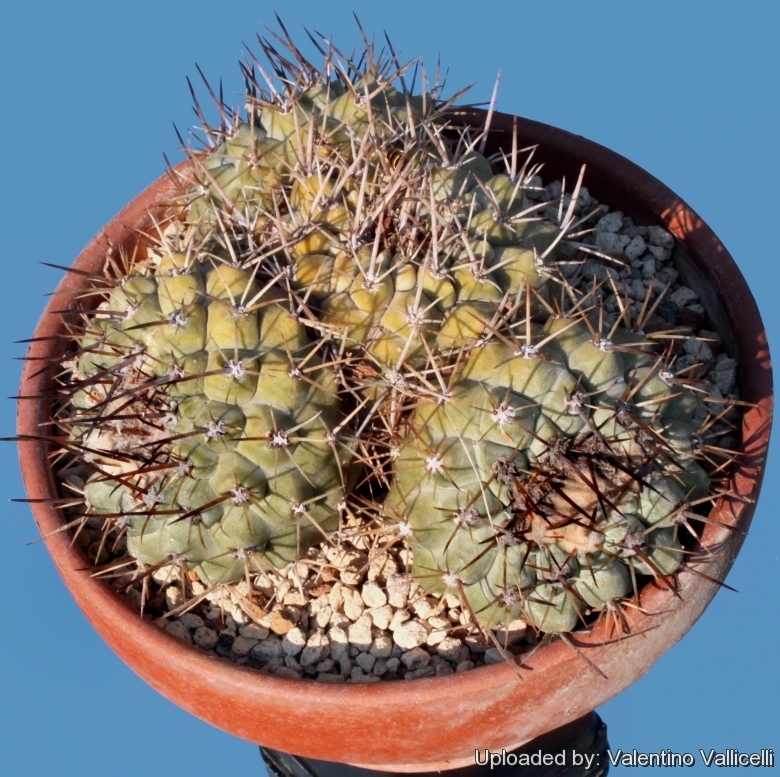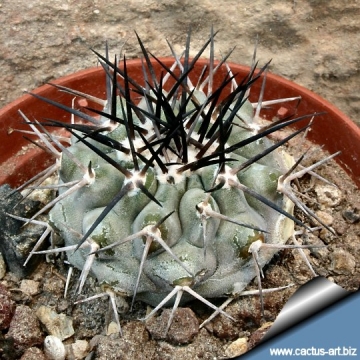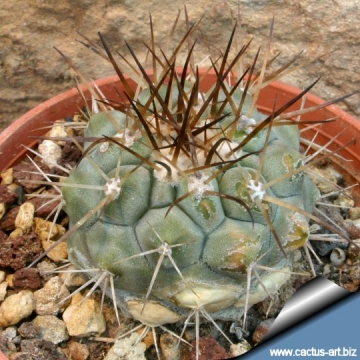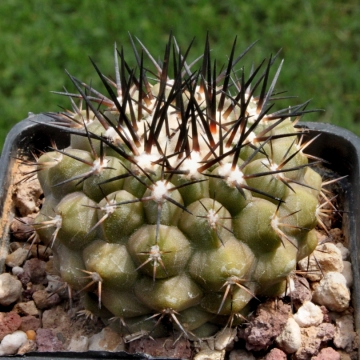Accepted Scientific Name: Copiapoa cinerea
Cactaceae (Britton & Rose) 3: 86. 1922 [12 Oct 1922]

Copiapoa cinerea Serra Vetata Photo by: Valentino Vallicelli
Origin and Habitat: Origin: Serra Vetata (Taltal), Antofagasta, Chañaral regions of northern Chile
Habitat: Coastal areas of South America, where it grows in areas where very little else grows. It's a very drought tolerant species. Despite the lack of rain where it lives, the extreme aridity is attenuated by the frequent, often dense, coastal fogs. The fog tends to concentrate in the form of a cloud band at an estimated height of 500 to 850 m. It shows a recurrent pattern; usually it is overcast in the early mornings, the clouds dissipating during the late morning and returning during the late afternoons.
Synonyms:
See all synonyms of Copiapoa cinerea
Description: The name Copiapoa cinerea from Serra Vetata can be referred to a form or clonotype within the variability of Copiapoa cinereaSN|1380]]SN|1380]]. This species shows great variation and it is sometimes difficult to separate one local form from another. Many of this forms have received unnecessary names. The cinera population from Serra Vetata is characterized by strongly tubercled ribs (at least when young).
Remarks: Copipoa cinerea is a very variable species, as is demonstrated by the number of varieties and their synonyms. The several classifications and reclassifications provide evidence of the confusion that rules regarding the names used in this highly variable species. It seems that many of botanists and hobbyists who have studied Copiapoa in habitat have formed their own concepts of what names should be applied to which plants. It is relatively easy to attribute some key features that dominate in certain populations, but it is equally possible to look more closely at plants in these populations, to find individuals that 'break the rules' and would easily fit another population's dominant characteristics.
Bibliography: Major references and further lectures
1) Edward Anderson “The Cactus family” Timber Press, Incorporated, 2001
2) James Cullen, Sabina G. Knees, H. Suzanne Cubey "The European Garden Flora Flowering Plants: A Manual for the Identification of Plants Cultivated in Europe, Both Out-of-Doors and Under Glass" Cambridge University Press, 11/Aug/2011
3) David R Hunt; Nigel P Taylor; Graham Charles; International Cactaceae Systematics Group. "The New Cactus Lexicon" dh books, 2006
4) N. L. Britton, J. N. Rose “The Cactaceae. Descriptions and Illustrations of Plants of the Cactus Family.” Volume 4, The Carnegie Institution of Washington, Washington 1923
5) Urs Eggli, Leonard E. Newton “Etymological Dictionary of Succulent Plant Names” Birkhäuser 2004.
6) F.Ritter “Kakteen Südamerika” 3: 1072 1980.
7) Graham Charles “Copiapoa” Cirio Pub. Services, 1999
8) Adriana Hoffmann “Cactáceas en la Flora Silvestre de Chile” 1st edition, 1989
 Copiapoa cinerea Serra Vetata Photo by: Cactus Art
Copiapoa cinerea Serra Vetata Photo by: Cactus Art Copiapoa cinerea Serra Vetata Photo by: Valentino Vallicelli
Copiapoa cinerea Serra Vetata Photo by: Valentino Vallicelli Copiapoa cinerea Serra Vetata Photo by: Cactus Art
Copiapoa cinerea Serra Vetata Photo by: Cactus Art Copiapoa cinerea Serra Vetata Photo by: Cactus Art
Copiapoa cinerea Serra Vetata Photo by: Cactus ArtCultivation and Propagation: Considering that Copiapoa cineres comes from a habitat with an extremely arid climate, they are remarkably tolerant of pot culture. These plants have taproots and are susceptible to overwatering. They requires also an appropriate air circulation. Copiapoas are summer grower species easy to cultivate.
Growth rate: This is a slow growing cactus kept for the beauty of its form that will make clumps given the best conditions.
Soils: It likes very coarse mineral cactus mix soil, but can become too elongated if compost is too rich.
Repotting: Use pot with good drainage.
Watering: It requires light but regular waterings in summer, but let the soil mix dry between waterings, but do not overwater (Rot prone), it must be strictly kept dry throughout the winter quiescent period since it is very sensitive to any moisture excesses keep dry in winter.
Fertilization: Feed with a high potassium fertilizer in summer.
Hardiness: Not highly tolerant of a great deal of frost. They need to be kept in a cool place during winter rest and are resistant to light frost if kept on the dry side prior to, and during, cold weather ( they are hardy to -2 C ° C short periods). However some warmth throughout the year will increase the grower's success (minimum 5° to 10°C during rest season).
Exposition: Requires full sun or light shade and careful watering to keep plant compact with strong coloured spines. Tends to bronze in strong light, which encourages flowering and heavy spine production. Light shadow my be useful in the hottest summer days.
Uses: It is an excellent plant for container growing. It always looks good and stays small. It look fine in a cold greenhouse and frame or outdoor in a rockery.
Pests & diseases: It may be attractive to a variety of insects, but plants in good condition should be nearly pest-free, particularly if they are grown in a mineral potting-mix, with good exposure and ventilation. Nonetheless, there are several pests to watch for:
- Red spiders: Red spiders may be effectively rubbed up by watering the infested plants from above.
- Mealy bugs: Mealy bugs occasionally develop aerial into the new growth among the wool with disfiguring results, but the worst types develop underground on the roots and are invisible except by their effects.
- Scales: Scales are rarely a problem. It is wise to treat your whole collection with a systemic insecticide twice a year in spring and autumn.
- Rot: Rot is only a minor problem with cacti if the plants are watered and “aired” correctly. If they are not, fungicides won't help all that much. To prevent rottenness it is also advisable to surround its root neck by very rough sand or grit, this help a fast water drainage.
Propagation: Seeds (or offsets if available), Grafting is often used to speed growth rate and to create a back-up to plants in collection. Seeds germinate in 7-14 days at 21-27° C in spring, remove gradually the glass cover as soon the plants will be well rooted (ca 1-2 weeks) and keep ventilated, no full sun for young plants!














